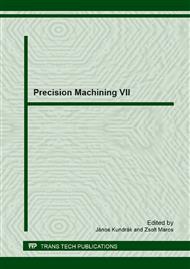[1]
K. Weinert, D. Biermann: Spanende Fertigung. Vulkan Verl., Essen, (2008).
Google Scholar
[2]
J. P. Davim (ed. ): Surface Integrity in Machining. Springer, London, (2010).
Google Scholar
[3]
E. Brinksmeier: Prozeß- und Werkstückqualität in der Feinbearbeitung. Habilitation Universität Hannover. VDI Verlag, Düsseldorf, (1991).
Google Scholar
[4]
J. Beňo. I. Maňková, M. Vrabel, D. Kottfer: Roughness measurement methodology for selection of tool inserts. Measurement, Vol. 46, 2013, pp.582-592.
DOI: 10.1016/j.measurement.2012.08.017
Google Scholar
[5]
J. Kundrak: The scientific principles of increasing the effectiveness of inner surfaces' cutting with CBN tools. Academic Doctoral Dissertation. Kharkov, 1996 p.368. (In Russian).
Google Scholar
[6]
W. Zębala, B. Słodki: Cutting data correction in Inconel 718 turning. International Journal of Advanced Manufacturing Technology, Vol. 63, 2013, pp.881-893.
DOI: 10.1007/s00170-012-4225-x
Google Scholar
[7]
Y. Ohbuchi, T. Obikawa: Finite element modeling of formation in the domain of negative rake angle cutting. Transactions of the ASME, Vol. 125, 2003, pp.324-332.
DOI: 10.1115/1.1590999
Google Scholar
[8]
J. Beňo: Theory of Metal Cutting (in Slovakian). Vienala Košice, (1999).
Google Scholar
[9]
N. Fang: Tool-chip friction in machining with a large negative rake angle tool. Wear, Vol. 258, 2005, pp.890-897.
DOI: 10.1016/j.wear.2004.09.047
Google Scholar
[10]
V. P. Astakhov: Metal Cutting Mechanics, CRC Press, Boca Raton, (1999).
Google Scholar
[11]
Third Wave AdvantedgeTM User's Manual, Version 5. 9.
Google Scholar
[12]
I. Al-Zkeri: Finite Element Modeling of Hard Turning. VDM Verl., Saarbrücken, (2008).
Google Scholar
[13]
CSN 41 4220/ISO 683/11-73.
Google Scholar
[14]
D. A. Stephenson, J. S. Agapiou: Metal Cutting Theory and Practice. CRC Press, Boca Raton USA, (2005).
Google Scholar
[15]
G. Totten, M. Howes, T. Inone (ed. ): Handbook of Residual Stress and Deformation of Steel. ASM International, Ohio, 2002, pp.3-8., 437-453. ISBN 0-87170-729-2.
Google Scholar
[16]
Y. Matsumoto, M. M. Barash, C. R. Liu: Residual Stress in the Machined Surface of Hardened Steel. ASME PED Vol 12. pp.193-204.
Google Scholar
[17]
G. Szabo, J. Kundrak: Investigation on coherences between residual stresses and tool geometry by hard turning. Hungarian Journal of Industrial Chemistry. Vol. 39/2, 2011, pp.289-294.
Google Scholar
[18]
Z. Pálmai, M. Takács, B. Zs. Farkas: Validation of new flank wear by different methods. Material Science Forum. Vol. 729, 2012. pp.169-174.
DOI: 10.4028/www.scientific.net/msf.729.169
Google Scholar


